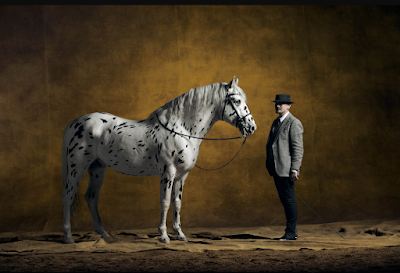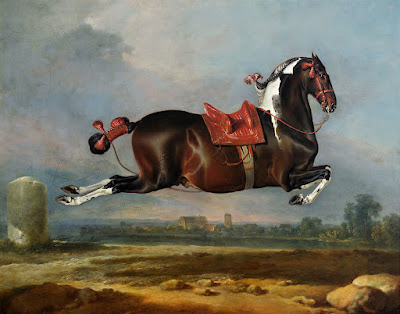Let's talk about somethin' that's a huge problem when I search for historic appaloosa painting:
Knowing for sure if the painter have done a spotted horse or a dappled horse... because it happend that I found a painting and then a friend told me "but that one? that's just the painter who wanted to do a dapple but failed".
So let's be clear, here's how I determine if I have dapples or spots in front of me ON A PAINTING (this is not an article about genetic, it's about what is drawn in front of me, right?!)
It's a SPOTTED appaloosa horse...
-If the horse have a light base and dark spots.
-If the horse have a dark base but white and/or spotted bump.
-If the horse have a black base but light spots on (snowflake).
-If the horse may have really solid appaloosa vibes like dark color around the bones zone of it's body.
Yann Arthus Bertrand : Knabstrupper (Knabsrup), Hugin.
Yann Arthus Bertrand : 'English' Appaloosa, Spottie Dot Com.
It's a DAPPLE horse if...
-If the horse have a dark base and light spots. Usually base would be grey or brown.
-If the horse have a medium/light base with white spots.
Yann Arthus Bertrand : 'English' Hunter, Ivanhoe.
Also, I've seen that MOST of the painters know what they do, thinking they are all lame is not a great way of seeing things. Even medieval painters depicted dapples perfectly with their naive drawings.
So in my view, that's a dappled horse:
So in my view, that's a dappled horse:
Most likely this one is a spotted horse, even if you can have a doubt:
But that horse? A spotted horse with no doubts...
But, wait, you know a thing?
It can be more difficult than that. Because if by our day, spotted horses are known as "appaloosa color" it wasn't in ancient time. No no...
Seems like they didn't do distinction between our famous spotted horses and our famous dappled horses... let's see thoses paintings names:
Aelbert Cuyp (1620-1691): A Dapple Grey Horse
(With my logic: Grey "Dapple" Horse)
Van Calraet, Abraham (1642-1722): A Dappled Stallion with a dog in a stable
(With my logic: Spotted "Appaloosa" Horse)
Baron Reis d' Eisenberg (1685-1764): No 29 A dappled grey horse of the Spanish Riding School performing a dressage movement
(With my logic: Spotted "Appaloosa" Horse)
Philipp Ferdinand de Hamilton (1664-1750) : Vast hilly landscape with a saddled dappled-grey and horses at a watering place
(With my logic: Spotted "Appaloosa" Horse)
Aaand if you thinks by now we are done, we just started our journey, take a look at this one title:
| Johann Georg Von Hamilton (1672-1737): Portrait of a dappled horse from the stud at Eisgrub performing the Levade | ||
(With my logic: Spotted "Paint" Horse)
Oh dear... we are in trouble...
So let's define a new spotted color...
It's a spotted PAINT horse...
-If the horse have large spots like a common cow pattern instead of dots, no matters the color.
Yann Arthus Bertrand : Pottock stallion, Judo.
That color, with "paint" spots is most of the time called SKEWBALD (and they are very commons, much more than our spotted appaloosa):
John Ferneley (1782-1860): 'Lofty', a Skewbald Carriage Horse, with a Greyhound
(With my logic: Spotted "Paint" Horse)
Wouter Verschuur the Younger (1841 - 1936): Two Skewbalds Horses in a Stable
(With my logic: Spotted "Paint" Horse)
J. Harris (1861-1884): Two Skewbalds Hoses by a Stable
(With my logic: Spotted "Paint" Horse)
But there's another name for that "paint" color... wich can also be a matchy matchy for our spotted horses... the infamous PIEBALD denomination:
Johann Georg Von Hamilton (1672-1737): The Piebald Horse 'Cehero' Performing Cabriole
(With my logic: Spotted "Paint" Horse)
Paulus Potter (1625-1654): The Piebald Horse
(With my logic: Spotted "Appaloosa" Horse)
Pieter Cornelisz. Verbeeck (1610 - 1654): A piebald horse tied to a hitching post and two dogs before an inn
(With my logic: Spotted "Appaloosa" Horse)
So let's be clear: the Spotted Horse were a thing in history. There's no discussion to be about that. But they weren't just identified as it with a clear name.
Oh wait.. there was a supposed name... TIGER HORSE... but I see it very rarely.
(With my logic: both Spotted "Appaloosa" Horse)
David Klöcker Ehrenstrahl (1628-1698) : Blue Tiger, favorite horse of King Charles XI
(With my logic: Spotted "Appaloosa" Horse)
(With my logic: Spotted "Appaloosa" Horse)
While we are here, let's talk about one other tricky color that can makes my search difficult... the roan horse. Because that search of the truth have no end.
It's a ROAN horse...
-If at least the head and legs are darker than the body, with most likely no to barely no spots.
Yann Arthus Bertrand: Rhenish Westphalian Draught stallion, Hurrican.
Thoses are really difficult because you can really sees anything when a painter do a roan.
Die Gartenlaube (1886)
(With my logic: "Roan" maybe "Paint" Horse)
And I have to be honest, roan horses gaves me real headeaches somethimes, because when I first see this...
Johann Heinrich Roos (1631–1685): Zigeunerlager in antiken Ruinen
(With my logic: eeerrrrhhh a "Roan" Horse)
I spot spots... but that is most likely just a roan one with scars. Let's be honest.
But when I see this...
Józef Brandt (1841-1915): Caravan On The Move
(With my logic: "Roan" probably "Appaloosa" Horse)
My head explose. I really sees an appaloosa, but I may really want to see one where they are only a roan one. We will never know.
Luckily for me, somethimes I have just *no* doubts at all.
Wilhelm von Diez (1839-1907): Soldier feeding horses
(With my logic: Roan "Appaloosa" Horse)
Roan can even be tricky with greys horses that can be with appaloosas horses... real debate start here?
Let's define a last color.
It's a GREY/white horse...
-If it's plain grey, or plain white.
-If it's a dapple grey going white.
-If it's a dapple grey going white.
Yann Arthus Bertrand:Pure-bred Arab stalion, Almesdam-Patch.
We have do this again... no choice...
Pieter Cornelisz. Verbeeck (1610 - 1654): A grey horse tied to a hitching post before an inn.
(With my logic: "Grey" Horse)
Circle of John Ferneley: A grey horse.
(With my logic: Spotted "Appaloosa" Horse)
Otto Bache (1839-1927): A white horse.
(With my logic: Spotted "Appaloosa" Horse)
Roos Johan Heinrich (1631-1685): A peasant on horseback taming a wild horse.
(With my logic: Spotted "Appaloosa" Horse)
A few more... wich I am unsure but well, I see what I see. When spots aren't obvious it's always difficult, but spotted horse can be unspotted so...
(With my logic: Spotted "Appaloosa" Horse & Spotted "Paint" Horse)
Philips Wouwermans (1619-1668): The wathering place.
(With my logic: Spotted "Appaloosa" Horse)
(With my logic: Spotted "Appaloosa" Horse)
*
Another factor that might not help, is that some painter just have done all thoses colors, so they were aware of all of them and could have mixed the names or my sources most likely can have mixed the names. Quality of the images might not help at all too. Somethimes also, the names are clear and you just follow them. Let's see some final example:
Baron Reis d' Eisenberg: No 21 A Danish horse with a dappled grey rump of the Spanish Riding School performing dressage steps.
(With my logic: Spotted "Appaloosa" Horse)
Baron Reis Eisenberg: No 51 A dappled grey horse of the Spanish Riding School performing a dressage move.
(With my logic: Grey "Dapple" Horse)
Baron Reis Eisenberg: No 8 A piebald horse and rider from the Spanish Riding School.
(With my logic: Spotted "Paint" Horse)
Baron Reis Eisenberg: No 41 A skewbald horse of the Spanish Riding School performing the Pesade.
(With my logic: Spotted "Paint" Horse)
Baron Reis d' Eisenberg - No 26 A red roan horse of the Spanish Riding School performing dressage steps.
(With my logic: Spotted "Appaloosa" Horse)
(With my logic: Spotted "Paint" Horse)
Thomas Weaver (1774 - 184): Appaloosa Horse And Spaniel.
(With my logic: Spotted "Appaloosa" Horse)
Thomas Weaver (1774 - 184): A Grey Mare, 'Rose', and a Portuguese Bay Hunter.
(With my logic: "Grey" Horse & maybe "Roan" Horse)
*
My conclusion: Spotted Appaloosa are my favorite, with Dappled Horse (but I prefers appaloosa because dappled just finish plain grey/white at the end).
When I was a child, my father always told me that he loved the fact that for horses, that loves apples, the dapple carryied their own apple. (it works in french too: apple = pomme / dapple = pommelé)
When I was a child, my father always told me that he loved the fact that for horses, that loves apples, the dapple carryied their own apple. (it works in french too: apple = pomme / dapple = pommelé)
I agree with him.
I'm also glad to have found so many historic spotted horses references.
I'm also glad to have found so many historic spotted horses references.
Adam Frans van der Meulen (1632-1690): A Pair, Chevaux au repos.
(With my logic: Three Spotted "Appaloosa" Horse / one flaxen chestnut, one dilute (palomino or cream), one "Grey", two Spotted "Paint" horses)
(With my logic: Three Spotted "Appaloosa" Horse / one flaxen chestnut, one dilute (palomino or cream), one "Grey", two Spotted "Paint" horses)















































Aucun commentaire:
Enregistrer un commentaire